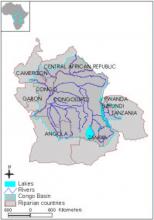Informations générale

BP 12645, Kishasha, DRC
Données de base
Varies from 720 mm/year in the Tanzanian part of the basin to 2115 mm/year in D.R. Congo with an average of 1470 mm/year over the whole basin.
Irrigation potential figures in the basin vary between 4 and 20 million hectares.
Site Internet
Couverture géographique
The basin consists of the Congo river itself, its tributaries of Oubangui, Kasai, Sangha, Kuilu, Kwango, Ruki, Lamami, Lulonga, Amwini and smaller rivers.
| Pays | Superficie |
|---|---|
|
Angola
|
291500km²
|
|
Burundi
|
14300km²
|
|
Cameroun
|
85300km²
|
|
Centrafrique
|
402000km²
|
|
Rép. Dém. du Congo
|
2307800km²
|
|
Congo
|
248400km²
|
|
Gabon
|
460km²
|
|
Malawi
|
90km²
|
|
Rwanda
|
4500km²
|
|
Tanzanie
|
166800km²
|
|
Zambie
|
176600km²
|
Fonction/mandat
Fonctionnement
No established basin-wide cooperative framework for management and development of the Congo River Basin. Conflicts among member countries have occurred from time to time.
Bases légales
| Date | Nom du traité | Signataires | Bassin |
|---|---|---|---|
|
1885-02-26
|
Conference of Berlin
|
Austria
Belgium
Denmark
France
Italy
Russia
Netherlands
Spain
Great Britain
Germany
Sweden
Norway
Turkey
Portugal
USA
Hungary
|
Bassin du Congo
|
|
1927-07-20
|
Economic Convention
|
Belgium
Portugal
|
- |
Challenges
Very vast basin , weak economies exacerbated by a long history of conflicts, water security, cooperation for basin development and management, lack of sound basin data, need for capacity building and limited funds.
 AWIS/Sadieau
AWIS/Sadieau